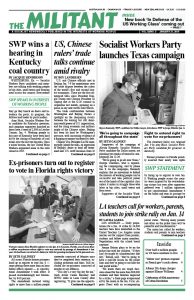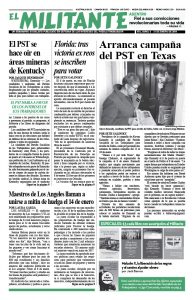As part of the economic upturn in the U.S., more than 550,000 working people were homeless last year, according to the Department of Housing and Urban Development. High rents and low wages account for what would seem to be a contradiction, but in fact is a reflection of the underlying capitalist crisis that affects working people today.
The gulf between the conditions of life for workers and working farmers and those enjoyed by the capitalists and their meritocratic enablers continues to widen.
Federal Reserve Chair Jerome Powell has insisted all year that the U.S. economy is almost “too good to be true.” Maybe that’s true for him. But in mid-December even he had to admit, “The benefits of this strong economy and sound financial system have not reached all Americans.”
Conditions of life facing working people certainly bear this out. Four in 10 adults say they don’t have enough savings to cover a $400 emergency expense, Powell’s Federal Reserve reports. Some 4.8 million workers who want full-time employment are stuck in part-time jobs. Suicide rates are so high — 129 a day on average — that life expectancy is now declining in the U.S.
The actual figures for people with nowhere to live are probably much higher than the HUD report indicates since some cities like San Francisco didn’t choose to participate in the survey. Other areas did their “head count” only for one night in January 2018, tabulating those registered in shelters or who were seen “unsheltered” on the streets.
On any given night in California, HUD said, 134,000 people are without housing, the most in any state. The state’s homeless population rose 13.7 percent between 2016 and 2017.
Since 2007 homelessness has increased by nearly 47 percent in New York. And in North Dakota, it has risen by over 70 percent.
Families with children represented one-third of the total homeless population in 2018, according to the report. But in some areas it’s much higher.
In October 2018 family members comprised three-quarters of the 63,559 people sleeping each night in New York City’s shelter system, according to the Coalition for the Homeless. This doesn’t count the thousands who stay away from these shelters given the abysmal conditions that exist at many of them.
The number of those homeless who work either full-time, part-time or temporary jobs is rising. In Washington, D.C., a 2017 report says that 22 percent of homeless single adults and 25 percent of adults in homeless families there have jobs. A spokesperson from New York’s Department of Homeless Services told the press that 34 percent of families in the city’s homeless shelters include a working adult.
‘Ten years without heat’
And those able to gain access to low-rent public housing in New York City, sometimes after years of waiting, then confront deteriorating and dangerous living conditions. As landlord for nearly 400,000 people, the New York City Housing Authority “has been accused of malfeasance, mismanagement and of mishandling the removal of lead paint and mold from its apartments,” the New York Times reported Dec. 19.
At one of the city’s units on Eagle Avenue in the South Bronx, residents have been without heat for the past decade, the Times says, as their complaints have been ignored.
“I haven’t had heat for 12 years,” pre-kindergarten teacher Wanda Agee told the paper. She and her husband Larry, a hotel maintenance worker, have been living in that building since 1986. And they’re forced to pay onerous monthly electricity bills to power the several space heaters they have to use to get by.
Landlords in New York are legally required to maintain heat inside residential buildings of at least 68 degrees if the temperature outside falls below 55 degrees, and at least 62 degrees inside at night. But the city chooses not to enforce these laws at buildings owned by its housing authority.


